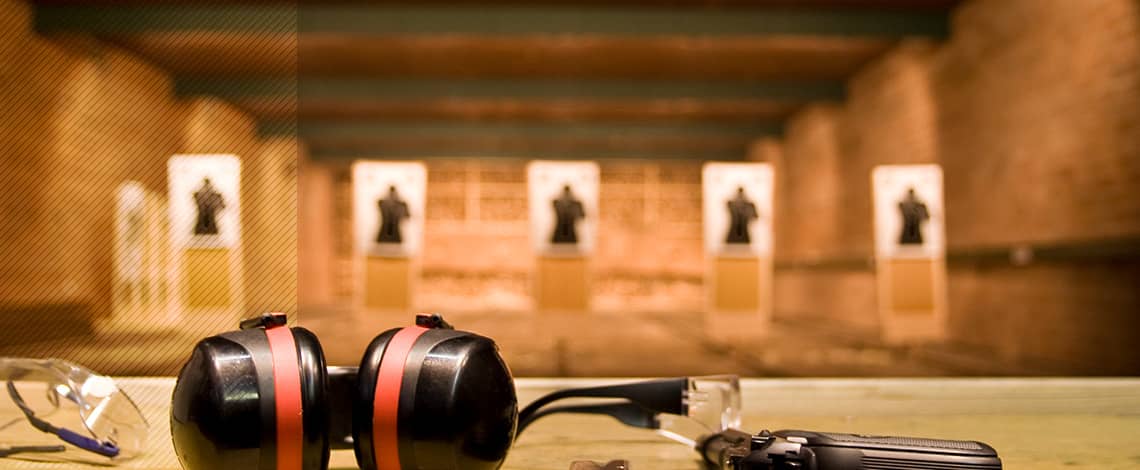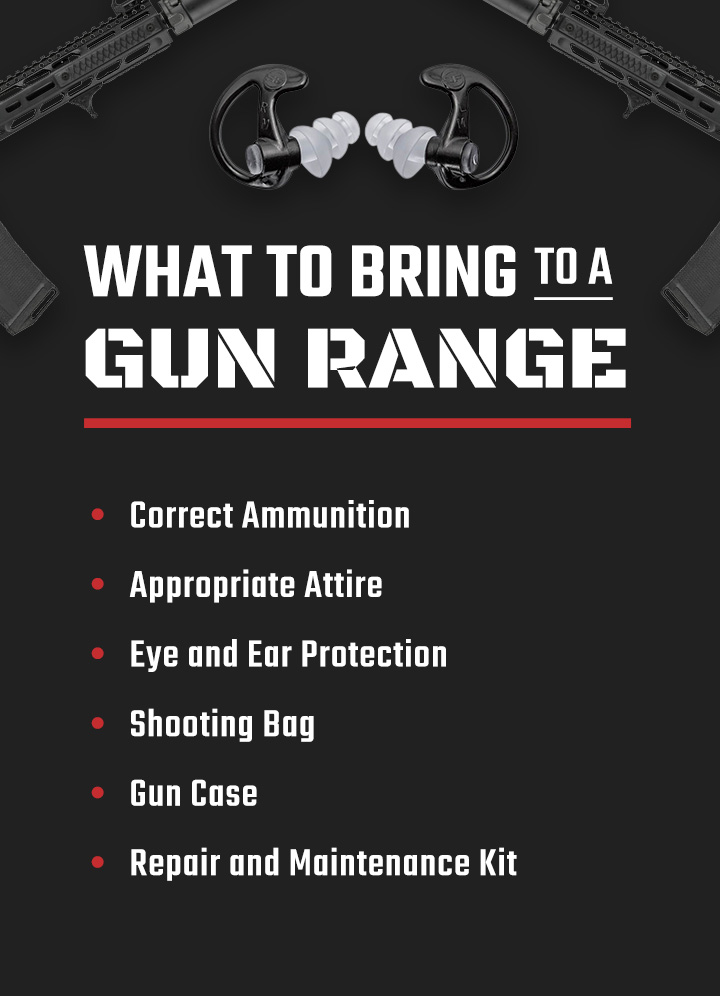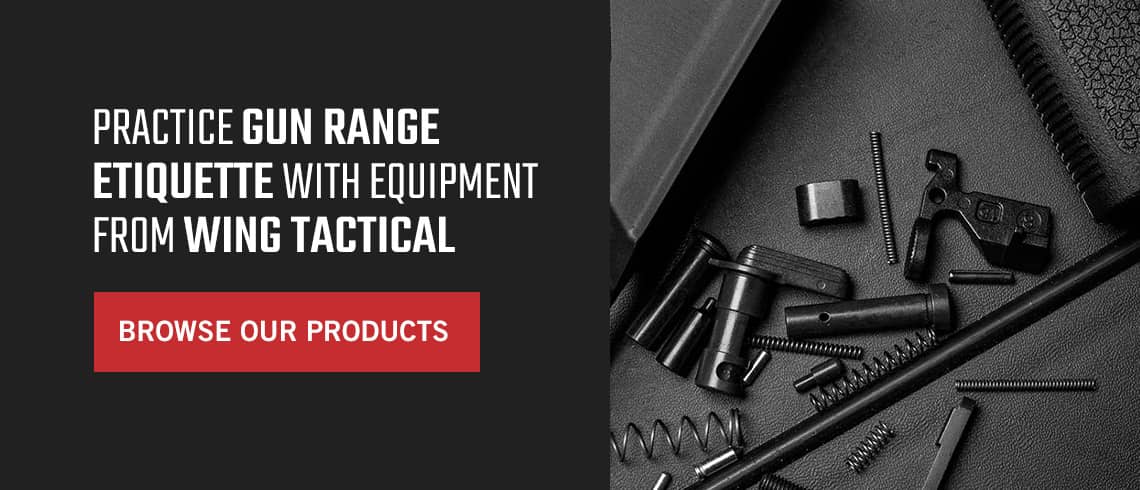
Going to a shooting range is a great way to unwind, refine your skills and interact with new and seasoned shooters alike. However, safety should always come first with any hobby or activity, especially where a powerful firearm is involved.
Whether it's your first time visiting a gun range or you've been shooting recreationally for years, practicing proper gun range etiquette is critical for keeping everyone safe, including fellow range-goers, staff members and yourself.
Gun Range Safety Tips
Knowing the universal gun safety rules is essential before stepping foot in a range. Always exercise the handgun safety tips below when practicing at a range or any other shooting site:
1. Treat Every Gun Like It's Loaded
First, deal with every firearm as if it's loaded at all times. Even if you've double- or triple-checked the chamber, you want to continue handling it in the same manner you would a loaded gun. Doing so helps you develop good firearm handling habits.
Additionally, remember that your firearm should only be loaded when you're in the shooting area, ready to fire. Unload your gun as soon as you're finished shooting. If someone hands you a gun and tells you it's unloaded, don't just take their word for it — inspect the chamber yourself to confirm it's truly empty.
2. Always Point the Muzzle in a Safe Direction
Always keep the muzzle pointed downrange, whether your gun is loaded or unloaded. Make a habit of knowing where the muzzle is pointing at all times, and never point it at anything you don't wish to shoot. This is especially important when loading or unloading a gun — in case of an unintentional discharge, no injury will occur provided the muzzle is pointed in a safe direction.
If you need to set your gun down on the bench, it should continue to face the targets and remain unloaded. The floor or ground is typically a safe direction, but you should also be aware of objects that can cause the bullet to ricochet, like a large rock or metal object. Once you're ready to shoot, only point the muzzle at items you intend to hit.
3. Keep Your Finger off the Trigger Until You're Ready to Fire

Proper trigger discipline — the practice of keeping your finger off the trigger until you're prepared to fire the gun — is vital. Exercising trigger discipline while you're between rounds can prevent accidental discharges.
Place your finger across the outside of the trigger guard and refrain from shifting it to the trigger until you're ready to shoot. It's also best to keep the safety on when you aren't ready to fire.
4. Know Your Target and What's Beyond It
Finally, you should know exactly what you're pointing your muzzle at and what's beyond your target before firing. Shooting at a noise or movement without being absolutely certain of what you're firing at disregards the safety of others.
Don't shoot unless you know what you're going to strike. That way, you can ensure you don't injure anyone or hit anything beyond your target.
Terms to Know at the Range
Next, let's review some key terms and phrases to know when practicing at a gun range:
1. Range Safety Officer (RSO)
Also called the “range master,” the RSO is responsible for enforcing gun range rules and procedures, supervising shooters, shouting out range commands and addressing any possible problems.
2. Firing Lane
The firing lane is the designated area for shooters to aim and fire. It usually includes a shooting bench or booth. Most gun ranges have multiple lanes running parallel to each other, and you must stay in your own lane. It's both impolite and unsafe to intrude on another shooter's space.
3. Firing Line
This is where you position yourself to prepare for shooting. The firing line is either visibly marked on the ground or clarified as a specific location by the RSO. In some firing lanes, the shooting bench serves as this line. Only shooters are permitted on the firing line.

4. Downrange
This term refers to the end of a gun range where targets are placed, or any point past the shooters and line of fire. The RSO will order shooters to cease firing when someone is standing or walking downrange.
5. Hot and Cold
RSOs call out “hot” and “cold” often, so these are essential terms to know. A hot range means that shooters are active, and you can commence shooting. No one should venture beyond the firing line during this time. When the range is cold, all shooters have unloaded their firearms and locked them open. You can only go downrange when the range is cold.
6. Clear
“Clear” indicates no one is downrange and the range is physically clear of any potential safety hazards. No one should commence shooting until the RSO confirms the range is clear.
7. Backstop
The backstop is the wall or barrier behind the targets. It's designed to stop stray bullets and projectiles that puncture the targets. The backstop typically appears as a back wall at indoor facilities. At outdoor ranges, it's usually a humanmade embankment of soil. Each time you fire, try to shoot straight and parallel to the ground so the backstop can safely block your bullets.
8. Ceasefire
As the name implies, “ceasefire” means to stop firing immediately. If anyone yells ceasefire, every shooter should remove their finger from the trigger, keep their muzzle pointed in a safe direction, unload the firearm and lock the slide or cylinder open. They should then place the gun on the bench, step behind the firing line, and await further instructions from the RSO.
What to Do During a Ceasefire
An RSO can call for a ceasefire at any point while you're at the range, so remain alert at all times.
Before stepping back, ensure you have everything needed for the break, as you can't return past the line until the RSO permits you to do so. These rules are enforced to ensure everyone's safety.
During a ceasefire, authorized shooters and staff can go downrange to check targets and equipment, perform range maintenance checks or replace targets. People who walk down the lanes trust other shooters to keep them safe. Touching any firearm or passing the line during a ceasefire is prohibited.
While you're behind the firing line, you can take a moment to relax, socialize with other shooters, hydrate or reset your focus before returning to the firing line. Once downrange is clear and everyone is ready to continue, the RSO will give the command to commence firing. At this point, you can step past the line and resume practicing.
If you catch an issue at the range, such as a person walking downrange or a firearm malfunction, you can also call for a ceasefire. The RSO will then repeat your command to ensure everyone hears and follows the call.
What to Bring to a Gun Range
Besides understanding basic gun safety rules and range etiquette, it's important to bring the right supplies and equipment. This includes proper ammo, eye and ear protection and other crucial gear. Here are some essentials to cross off your list before heading to the range:

1. Correct Ammunition
Only use the ammo of the caliber the manufacturer designates for your gun. Using incorrect ammunition can destroy the gun or cause serious injury.
All modern firearms have markings that indicate the correct ammunition caliber or gauge. You can generally find these markings on the barrel, frame or receiver. Read and follow all warnings, including those on the ammunition boxes and in the gun's instruction manual. Ensure the ammo you're using matches the specifications on both the manufacturer's markings on the gun and those in the manual.
Ammo that has become very wet should be discarded safely. Don't spray solvents or oil on ammunition or load ammo into an overly lubricated gun. Build the habit of examining each cartridge you put into your firearm. Further, don't use substandard or damaged ammunition — the money you save isn't worth the risk of a ruined gun or injuring yourself or others.
2. Appropriate Attire
You don't have to cover every inch of your body when dressing for the range, but you should protect vulnerable areas for safety reasons. Here's some appropriate range attire to keep in mind:
- Higher necklines: Try to avoid shirts that leave exposed skin in the chest area. Your clothing serves as a barrier between your skin and ejected hot brass, so a higher neckline can offer more protection. You can also pack a scarf in your bag to protect your skin from hot brass.
- Close-toed shoes: Experts recommend shoes that cover your feet as much as possible, like sneakers or boots. Steer clear of open-toed shoes like sandals or flip-flops to protect your feet from ejected cartridges and hot brass.
- Pants: Wear comfy, loose-fitting pants — not shorts — that allow for proper stance and easy movement, such as cargo or tactical pants. These pants also have ample pockets for storing extra mags! Long pants cover more skin, meaning you'll be less likely to go home with a burn. If you're practicing drawing from a holster, ensure your pants and holster can accommodate your equipment.
- Hat: While hats are optional, they're highly encouraged at the range. In addition to providing shade, a hat can defend your head and face from ejected cartridges. It can also keep hair out of your eyes, preventing it from obstructing your sights and target view.
Before heading to the range, you might want to call the facility or check its website to see if there's a dress code. Some shooting ranges have specific dress code policies, like collared shirts only or no open-toed shoes.
3. Eye and Ear Protection
Always wear protective shooting glasses and hearing protection while at the range. Excessive exposure to shooting noises can damage hearing, so it's important to protect your ears with earplugs or muffs. Likewise, a pair of shooting glasses can guard your eyes against twigs, clay target chips and other debris, like rare ruptured cases or gun malfunctions.
4. Shooting Bag
A shooting bag comes in handy when you're bringing equipment to the range instead of renting it. It allows for easy storage and transport, keeping all of your belongings like firearms, ammo and safety gear together.
5. Gun Case
A gun case is the safest way to transport your firearm as opposed to walking into the range with an unprotected gun. You can either pack the case in a shooting bag or transport it separately. Before packing up the firearm, ensure you unload it and lock the action open. Remember to unpack and load your gun according to the range rules discussed above.
6. Repair and Maintenance Kit
There's always a chance you'll need to repair your gun while at the range, or at least clean or lubricate it. We recommend bringing a small repair or maintenance kit — that way, you can ensure you have everything you need and keep your firearm functioning properly.
Other Gun Range Etiquette Tips
Now that you've learned about firearm safety basics, proper equipment and how to handle a ceasefire, here are some additional gun range tips to wrap things up:
- Read the range rules: Aside from universal safety rules and practices, each range has a unique way of operating. For instance, you may be required to reserve a lane beforehand. The range may also have you sign a waiver stating that you've reviewed the rules and agree to abide by them. Be sure to read the range's regulations thoroughly, familiarizing yourself with its expectations.
- Listen to your RSO: If you follow the rules and pay attention to RSOs when they call out orders, you shouldn't run into any problems. If you're unknowingly doing something incorrectly, the RSO will let you know. If you see another shooter being unsafe, inform the RSO so they can handle it.
- Ask questions: Don't be afraid to ask your RSO questions. Clearing up any confusion improves your shooting safety. You can also let them know you're new so they can help get you started.
- Clean up: Always clean up after yourself when you're ready to leave the range. It's impolite to leave any gear or trash behind.
Above all, have fun!
Practice Gun Range Etiquette With Equipment From Wing Tactical
Having reliable, high-quality firearm equipment is another important aspect of range safety. Luckily, Wing Tactical is your one-stop shop for gun parts, tools and accessories. You can enjoy the following benefits when shopping with us:
- Easy 30-day returns.
- Discounts for law enforcement and military members.
- Quick next-day shipping.
- Outstanding customer service.
From Glock slides and AR-15 magazines to cleaning and maintenance supplies, we have everything you need to keep your gun functioning safely and properly. Browse our firearm products to find what you're looking for, or reach out with questions about finding the right parts.
